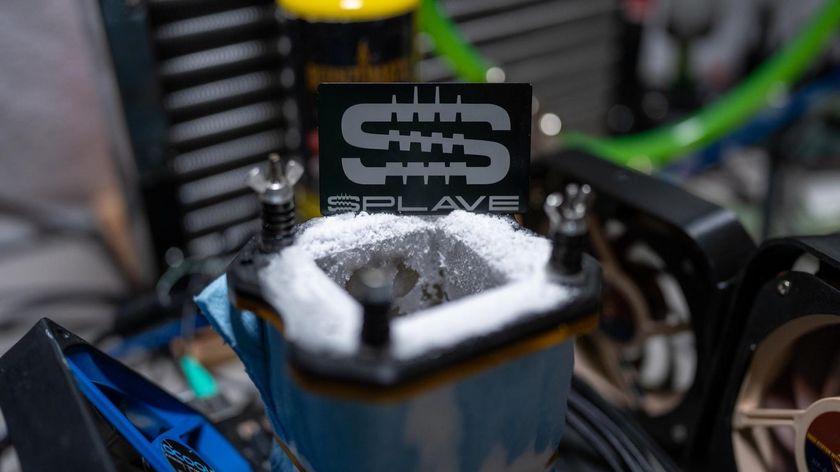How to Fix Your Motherboard for $15
How To Buy Substitute Low-ESR Capacitors

These are simple, radial electrolyte capacitors.
It was more difficult to buy special low ESR capacitors than we thought, since we kept an eye on cost. We think it makes sense to exchange capacitors if the process is inexpensive - keep in mind that the replacement process itself can go wrong and you would have to purchase a new motherboard plus processor(s) and RAM.
We needed 26 radial capacitors with a 1000µF capacity, 6.3 V and 105°C temperature resilience for our K7D Master. You can find the technical data on the capacitor's case. The capacitor's diameter is about 8 mm, its height is 16 mm, and the distance between the pins (anode and cathode) is 3.5 mm.

These are the capacitors we ordered.
After a little research we placed our order with a small dealer selling capacitors at scaled prices. We didn't get the desired capacitors with 6.3 V, but decided to go with 10 V models instead. Pin distance and diameter are the same on the replacement capacitors, but the new ones are 20 mm high instead of 16 mm. Depending on the motherboard you're repairing, 4 mm can cause some trouble. Before you order any replacement please find out how much space there is between the capacitors and expansion cards such as your graphics card, among others. We did not encounter any problems with a 4 mm difference in height. We paid 50 cents each for our 30 capacitors, shipping and handling not included.
Stay On the Cutting Edge: Get the Tom's Hardware Newsletter
Get Tom's Hardware's best news and in-depth reviews, straight to your inbox.
Current page: How To Buy Substitute Low-ESR Capacitors
Prev Page How To Recognize Flawed Capacitors Next Page Let's Get Started!-
Darkness Master Recognizing of broken capacitors is not so simple in some cases.Reply
Sometimes (very often in my case) have capacitor its nominal capacity but it has high serial current. When you connect DC voltage of capacitor nominal value and capacitor have some serial current throught it, then it is broken. Only charging current is allowed (short current peak on connect).
Sorry for my english. -
4655434b20594f55 Good article. I have personally made this repair sucessfully many times using only a basic hand held solding iron and hand held desolder pump.Reply
Like you say the motherboard sinks away the heat fast. You need an iron with between 70 and 100 watts and a large flat tip. If it spans both solder points of the cap its really easy :)
Just heat and gently pull the cap out from the other side of the board. Then clear the holes with the heated pin method or use a desolder pump. If you heat the hole on one side and use the pump on the other side it should clear easily.
Only other thing to note is. Be QUICK, practice on some junk board first, you dont want to burn a big hole in your board or lift of the tracks.
Im sure most people don't have a professional solder/desolder station. These cost at least $160 usually more. -
4655434b20594f55 Another trick. Assuming the old caps are dead and of no further use. Pull them off thier leads.Reply
If you pull a electrolytic capacitor hard the leads will pull straight out of the body of the cap.
Leaving just the leads sticking up. Its now much easier to remove becuase you can desolder the leads and remove them one at a time. -
Just trim the leads sticking out of the bottom of the board then heat one at a time while applying slight pressure to the capacitor towards the other lead. They pop right out. I use thecapking for capacitors online, fast free shipping.Reply
-
I use the Weller WLC100. It's consumer DIY soldering station, but more than meets the needs for motherboard soldering. Runs about $50. I've done 50+ boards easily with this station, but I use a precision tip instead of the big tip it comes with (usually run about $10). I also recommend Mouser or Digikey for capacitors, though beginners may find these sites overwhelming. TheCapking is a good place to find capacitor kits for common motherboards with faulty capacitors, and the site has diagrams in case you get confused where the capacitors need to go.Reply
-
runf I Turned on a computer that had been working. A short "pop", a fairly intense burning odor, and later I found a capacitor (I presume) on the bottom of my computer case:Reply
Here is a pic of the Asus P5-K. The green arrow points to where the capacitor used to sit.
http://jazzdrummer.com/capacitor2.jpg
First of all I'd like to know if it is indeed a capacitor and if not, what it is. Whatever it is, can I get another, solder it in and have any hope of fixing this board? I'm really clueless, if you can't tell. Any help would be greatly appreciated. This could be an opportunity for me to learn something. -
gabs110 I have a MSI mobo which I repaired some months back...replaced 2 caps. Lately, the same symptoms re-occured..pc starts up, fans run, lights light up but nothing else..no sound, no bios, no display. I replaced the same caps again thinking it might be malfunctioning but still nothing and no signs of any other failure. Any advice? My pc is a Acer Veriton M464 duo core.Reply -
Greg Hopkins Once you pull a mother board for any bad caps, you should replace them all. The caps are cheap compared to the down time and frustration. Some caps can fail with no obvious signs from the outside. My advise would be to change all the old caps with new low ESR Caps.Reply
Most Popular






